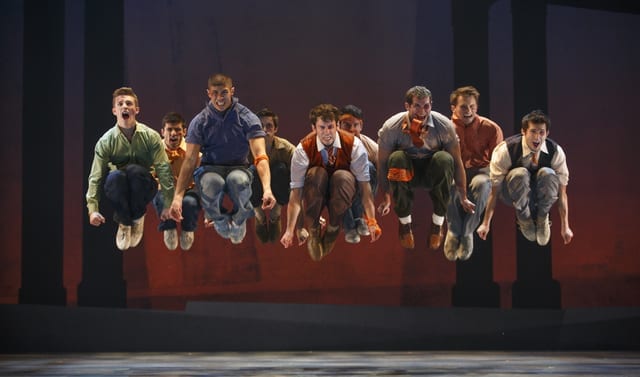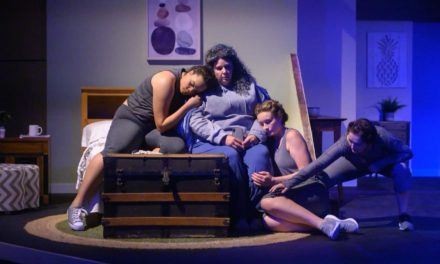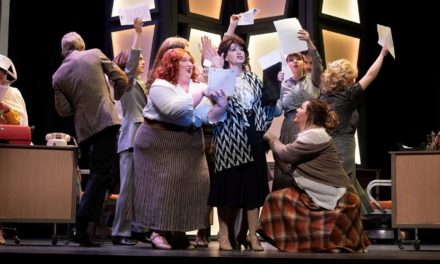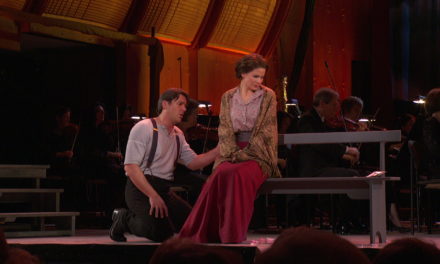SALT LAKE CITY — How do you make a classic new again? That’s the challenge posed to every director of a classic play. It’s not an easy demand to meet the conflicting desire to be original and the need to satisfy audience expectations. For Arthur Laurents, the decision to direct a new revival of West Side Story compounded these issues because he was a member of the original creative team. This made him run the risk of retreading the material and reviving stale ideas. I’m satisfied to report, though, that in the national tour of West Side Story, Laurents succeeded in presenting a show that was faithful to the original landmark Broadway production, while still seeming new and invigorating.
West Side Story is a musical adaptation of Shakespeare‘s Romeo and Juliet. In place of feuding Italians in Renaissance Verona, the “families” are opposing gangs of teenagers: the Jets, made up of Whites, and the Sharks, which consists of Puerto Ricans. Romeo is transformed into Tony, a Polish-American young man who is outgrowing the Jets, while Juliet becomes Maria, a young Puerto Rican teenager who recently arrived in New York City. The original 1957 production catapulted playwright Arthur Laurents and lyricist Stephen Sondheim (in the latter’s Broadway musical debut) to fame and made composer Leonard Benstein and director/choreographer Jerome Robbins household names. Moreover, West Side Story was a groundbreaking show that explored contemporary social problems in the neighborhoods near the Broadway theater where it originally played, unlike other musicals of the era that either avoided social discussion or were set in other time periods or distant locations (in the vein of Rodgers and Hammerstein). It is not an exaggeration to say that West Side Story paved the way for musicals like Hair, Company, or La Cage aux Folles.
The non-Equity national touring production of West Side Story recreates the direction of Arthur Laurents from the 2009 Broadway revival (his last in a long line of Broadway credits) and Jerome Robbins’s choreography from the original 1957 production; David Saint (direction) and Joey McKneely (choreography) are credited with reviving the Broadway staging. To update the half-century-old script and score, new Spanish lyrics were written by Lin-Manuel Miranda, a move which is largely successful. The result is a piece of musical theatre that is classic in its score and story, but fresh and new, while still faithful to the themes and artistic choices that made West Side Story a classic.
Heading this cast is Addison Reid Coe, who plays Tony as an eternal optimist who is naive of the true dangers that surround his relationship with Maria. Coe gives Tony an everyman quality that fosters sympathy for Tony’s plight. Coe also capitalizes on the musical and blocking of “Something’s Coming” (in contrast to the Jets’ actions in “Jet Song”) to distinguish Tony from his friends and show why only he could have fallen in love with a Puerto Rican. On the other hand, I disagreed with some of Coe’s vocal choices on the high notes in “Maria” and “Tonight,” but these issues were so minor that if I weren’t taking notes in order to write a review, I probably wouldn’t have thought twice about them. Opposite Coe playing Maria was MaryJoanna Grisso, who eschewed a traditional interpretation of Maria as a flighty, simplistic girl, and instead infused her with an understanding and cautiousness that added tension to the story. Grisso excels at playing off her fellow actors in endearing ways, as demonstrated by her unquestionably sweet interactions with Michelle Alves (who played Anita), and genuine raw emotion in “Tonight” with Coe.

Theo Lencicki (as Riff) and Blue Cervini (as Velma) dance in the mambo portion of the “Dance at the Gym,” while the Jets and their girls look on.
Another laudable performance was given by Louie Napoleon, a swing who played Action on opening night in Salt Lake City. Napoleon took the traditional feistiness of Action and added a degree of emotional instability, which was shown through a slightly detached, crazed look on Napoleon’s face (especially in “Gee, Officer Krupke!”) and some brilliant makeup design (not explicitly credited in the program, but Emily Baldwin is listed as “Head of Hair and Makeup”) that made him look emaciated. This made the second act, when Action takes over leadership of the Jets, fraught with more danger because the previous leader, Riff (Theo Lincicki), was a level-headed leader. Just as fascinating, but in a totally different way, was Michelle Alves as Anita, the sensual girlfriend of Bernardo (Andrés Acosta) and Maria’s coworker. Alves and Acosta had an undeniable sex appeal together as they danced in the mambo portion of the “Dance at the Gym,” and their playful banter before “America” showed that their characters’ relationship had a history that started long before the audience was introduced to them. Alves also handled the difficult “A Boy Like That/I Have a Love” scene well; many less talented performers have trouble making Anita’s shifts from heartbreak, to rage, to acceptance believable, but Alves demonstrated that these changes in Anita’s emotional states were plausible, despite the circumstances. Finally, Acosta was excellent and charismatic as Bernardo in the war council scene and played the part of a born leader well in the dance at the gym.
There were some minor problems I had with the performances of some of the other cast members. Some actors occasionally made errors in the Spanish dialogue (e.g., emphasizing the wrong syllable in “tardes” and “noches”). And understudy Melanie Wildman as Anybodys was not as vocally powerful during “Somewhere” as I had hoped, although her acting performance as the tomboy who wants to be a Jet was smart and charming. But these are insignificant complains that detracted little from what is a stellar ensemble cast who gave the best non-Equity performances I have seen since the national tour of the 2005 Sweeney Todd revival.
One reason I am so pleased with the cast as a whole is the precision in their execution of Jerome Robbins’s classic choreography. From the opening “Prologue,” through the vigorous mambo, the schizophrenic “Cool,” the comic “I Feel Pretty,” and more, every dance was entrancing to watch as the cast displayed their athleticism and artistry without error. But rather than a slavish reproduction of the original choreography (as can be seen in the 1961 film version), McKneely gave a lightness to the movement that emphasized the Robbins’s ballet-inspired choices, but did not seem foreign to the play’s reputation. I also applaud the touring production’s dance captains (Blue Cervini, who also played Velma, and Anthony Raimondi) for ensuring that the dances look crisp and new—not an easy task for a company on the road for a lengthy period of time.
Although the dancing was undeniably the highlight of the evening, Laurents’s direction was the major force that made this production of West Side Story exciting. The changes in the script, such as more full developing the Glad Hand (Matthew Krob) and Rosalia (Carolina Sanchez) characters, added to the depth of the story and made the context of Tony and Maria’s love more believable. Laurents also made minor changes that made the tragic ending of the story seem more inevitable (such as the uncertain musical ending in “One Hand, One Heart”) that inspired pathos for the characters. Laurents’s masterstroke in reconceiving West Side Story, though, was including Spanish dialogue and lyrics, which sometimes was quite humorous. This lent an air of authenticity to the Sharks and provided audience members who know the show well with a new experience. The only changes that I didn’t like were in the song “Dear, Officer Krupke!” because the alterations broke up the momentum of the song; I also found it weird that one of the Jets, A-rab (Max Chucker) just watched the song and didn’t participate in it.
One change that took me aback in this production of West Side Story were the costumes. Rather than a period 1950’s clothes for the gangs, the costumes (designed by David C. Woolard) were a blend of 1950’s fashion and modern trends (perhaps made easier by today’s Mad Men-inspired fashions). For example, the shirts for the Jets had a vintage feel to them, while their jeans were clearly influenced by 21st century tastes. Nevertheless, I found the choices to be remarkably unified, and the modern influences made the story more applicable today’s audience and kept the musical from becoming a period piece. I also enjoyed Woolard’s choices of color palletes: purples and blacks for the Sharks and orange for the Jets (with many exceptions so that the characters didn’t obviously look like they had been costumed). The color scheme, though, abruptly changed in the “Somewhere” ballet, where pastels and grays dominated, which made the fantasy nature of the scene clear.
In addition to the costumes, I was quite pleased with the lighting design by Howell Binkley. The powerful use of dark and light spaces on the stage made the gritty feel of the New York City streets come alive on a Salt Lake City stage. The lighting was breathtaking in the “Dance at the Gym” (with an opening that may be my favorite scene change I’ll see this year), which made the love-at-first-sight nature of the scene magical. I also enjoyed how the lighting, and its changes, was choreographed and perfectly timed with the music during the mambo, “Cool,” and “Somewhere.” On the other hand, the lighting on the upstage cyc in “Somewhere” was sometimes flat and almost muddy.
Although I have a few complaints about the production, I can wholeheartedly recommend it to any audience member in Utah. Thanks to the Spanish lyrics and dialogue, the smashing dance, and the strong performances, West Side Story is both classic and innovative, and an artistic success for everyone involved.










